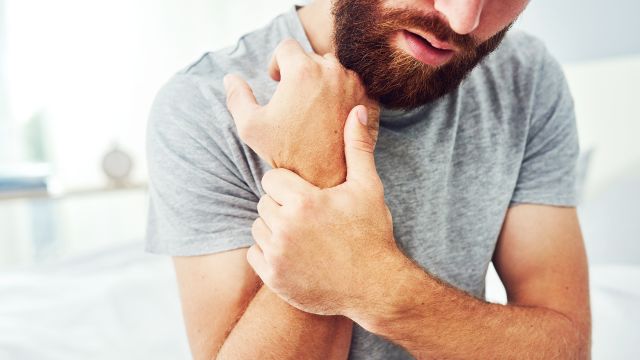Updated on January 7, 2022.
When you think of work-related injuries or occupational hazards, you may think of the black lung disease that plagues coal miners or mishaps involving dangerous machinery. By comparison, wrist pain seems mild. But a case of carpal tunnel syndrome (CTS) can keep you out of work for weeks, according to the Bureau of Labor Statistics.
CTS is often thought of as a white-collar worker condition, but that may not be true. In fact, it hasn’t actually been proven that typing or using a computer mouse causes CTS. And it’s not just a work-related condition. You can get it in association with injuries, arthritis, diabetes, and even pregnancy.
The carpal tunnel, explained
First, what is the carpal tunnel? It’s an inch-wide hollow space in your wrist, formed by the wrist bones and a ligament. Tendons that allow you to move your fingers as well as one of the main nerves for the hand all run through the carpal tunnel.
When the tunnel becomes narrow, such as when the tendons swell, pressure is applied to the nerve. Over time, this pressure can result in pain, tingling, numbness, and weakness in the hand. In severe cases, one’s ability to hold things using a pinch grip is weakened.
Who’s at risk?
Women are three times more likely than men to get CTS. Researchers think this may be because women’s wrists are usually smaller than men’s, and therefore their carpal tunnels are narrower.
Repetitive motion at work can also cause CTS, but not necessarily in the way you’d think. People who work on assembly lines seem to get CTS at higher rates than people who do data entry. And those who work with vibrating hand tools such as drills also often develop CTS.
Do you use a smartphone? If so, you should be careful.
A 2021 study of adults in Saudi Arabia published in Journal of Family Medicine and Primary Care linked smartphone use of four or more hours a day to a higher CTS risk. Similarly, a June 2017 study of 48 college students published in Muscle & Nerve found that those who used electronic devices for five hours a day or more had more wrist and hand pain than those who used their phones less. Another study published in 2019 in Journal of Hand Surgery linked heavy use of electronic devices, including computers, smartphones, and game consoles, to a thicker nerve within the carpal tunnel, which may contribute to carpal tunnel pain.
Other conditions associated with CTS include:
- Sprains and fractures
- Thyroid disease
- Arthritis
- Diabetes
- Pregnancy
- Pituitary gland disorders
CTS symptoms
The numbness, tingling, and pain that are the hallmarks of CTS begin gradually. They are often worse at night. Another classic indicator of CTS is waking up and needing to shake out the hand to make the symptoms stop. This is known as the “flick sign.” Sensations like these may come and go at first.
Weakness of the hand can be another, later sign of CTS. You may have difficulty performing fine motor tasks like buttoning your clothes.
What you can do
If CTS is left untreated, nerve damage can cause the symptoms to become permanent. Fortunately, treatments are available.
One of the first treatments to try is wearing a splint to keep the hand and wrist stable and supported. Wear the splint at night at first, and if symptoms persist, try wearing it during the day as well. Other treatments include heat, ice, anti-inflammatory painkiller medications such as ibuprofen (NSAIDs), and corticosteroids.
If you can, try to avoid or modify activities that make the symptoms worse. Taking breaks or putting cold packs on the wrist may help.
Another option is injection therapy. Steroids injected into the wrist can help ease pressure on the nerve. Steroid pills are also an option but don’t work as well.
There’s evidence that yoga can reduce pain and improve grip strength in CTS patients. Physical therapy, including a technique called therapeutic ultrasound, may also help.
If these don’t work, you can consider carpal tunnel release surgery. This is an outpatient surgery, so no hospital stay is necessary. It involves cutting through the ligament that’s pressing on the nerve in order to make more room in the tunnel. A surgeon will either open up the wrist or do endoscopic surgery through one or two small cuts. Recovery typically lasts two weeks, but it can take up to a year if you had a severe case. You’ll need to splint your wrist after the surgery and undergo physical therapy to strengthen the wrist and hand.
If your job puts you at risk for CTS because it involves repetitive hand movements, prevention can be tough. Use proper ergonomics at work, ask your employer about accommodations that may help you stay healthy, maintain good posture, and exercise your fingers, hands, wrists, forearms, shoulders, and neck.







